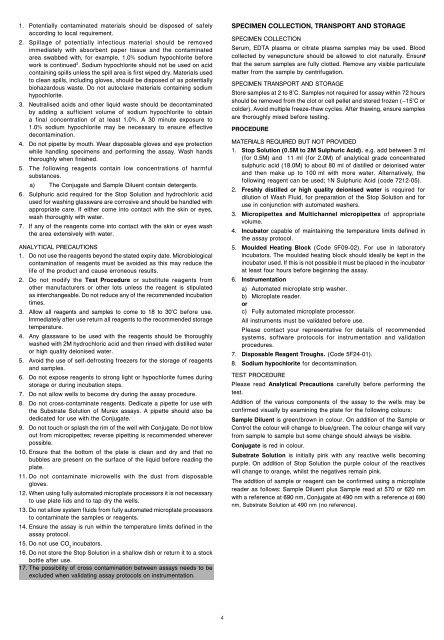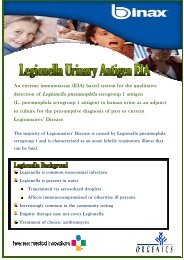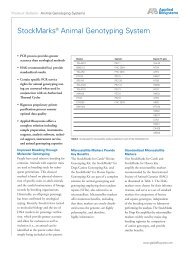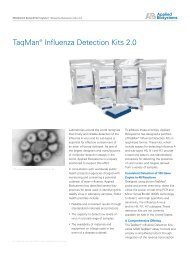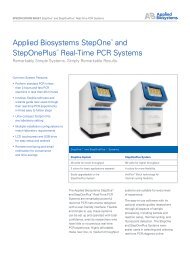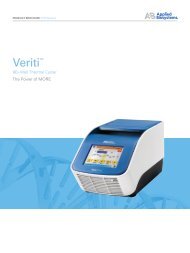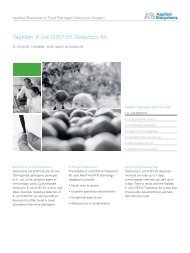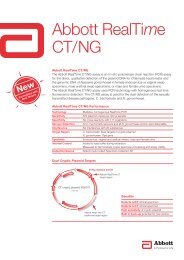Murex HBsAg Version 3
Murex HBsAg Version 3
Murex HBsAg Version 3
- TAGS
- murex
- hbsag
- nearmedic.ru
Create successful ePaper yourself
Turn your PDF publications into a flip-book with our unique Google optimized e-Paper software.
1. Potentially contaminated materials should be disposed of safely<br />
according to local requirement.<br />
2. Spillage of potentially infectious material should be removed<br />
immediately with absorbent paper tissue and the contaminated<br />
area swabbed with, for example, 1.0% sodium hypochlorite before<br />
work is continued 3 . Sodium hypochlorite should not be used on acid<br />
containing spills unless the spill area is first wiped dry. Materials used<br />
to clean spills, including gloves, should be disposed of as potentially<br />
biohazardous waste. Do not autoclave materials containing sodium<br />
hypochlorite.<br />
3. Neutralised acids and other liquid waste should be decontaminated<br />
by adding a sufficient volume of sodium hypochlorite to obtain<br />
a final concentration of at least 1.0%. A 30 minute exposure to<br />
1.0% sodium hypochlorite may be necessary to ensure effective<br />
decontamination.<br />
4. Do not pipette by mouth. Wear disposable gloves and eye protection<br />
while handling specimens and performing the assay. Wash hands<br />
thoroughly when finished.<br />
5. The following reagents contain low concentrations of harmful<br />
substances.<br />
a) The Conjugate and Sample Diluent contain detergents.<br />
6. Sulphuric acid required for the Stop Solution and hydrochloric acid<br />
used for washing glassware are corrosive and should be handled with<br />
appropriate care. If either come into contact with the skin or eyes,<br />
wash thoroughly with water.<br />
7. If any of the reagents come into contact with the skin or eyes wash<br />
the area extensively with water.<br />
ANALYTICAL PRECAUTIONS<br />
1. Do not use the reagents beyond the stated expiry date. Microbiological<br />
contamination of reagents must be avoided as this may reduce the<br />
life of the product and cause erroneous results.<br />
2. Do not modify the Test Procedure or substitute reagents from<br />
other manufacturers or other lots unless the reagent is stipulated<br />
as interchangeable. Do not reduce any of the recommended incubation<br />
times.<br />
3. Allow all reagents and samples to come to 18 to 30°C before use.<br />
Immediately after use return all reagents to the recommended storage<br />
temperature.<br />
4. Any glassware to be used with the reagents should be thoroughly<br />
washed with 2M hydrochloric acid and then rinsed with distilled water<br />
or high quality deionised water.<br />
5. Avoid the use of self-defrosting freezers for the storage of reagents<br />
and samples.<br />
6. Do not expose reagents to strong light or hypochlorite fumes during<br />
storage or during incubation steps.<br />
7. Do not allow wells to become dry during the assay procedure.<br />
8. Do not cross-contaminate reagents. Dedicate a pipette for use with<br />
the Substrate Solution of <strong>Murex</strong> assays. A pipette should also be<br />
dedicated for use with the Conjugate.<br />
9. Do not touch or splash the rim of the well with Conjugate. Do not blow<br />
out from micropipettes; reverse pipetting is recommended wherever<br />
possible.<br />
10. Ensure that the bottom of the plate is clean and dry and that no<br />
bubbles are present on the surface of the liquid before reading the<br />
plate.<br />
11. Do not contaminate microwells with the dust from disposable<br />
gloves.<br />
12. When using fully automated microplate processors it is not necessary<br />
to use plate lids and to tap dry the wells.<br />
13. Do not allow system fluids from fully automated microplate processors<br />
to contaminate the samples or reagents.<br />
14. Ensure the assay is run within the temperature limits defined in the<br />
assay protocol.<br />
15. Do not use CO 2 incubators.<br />
16. Do not store the Stop Solution in a shallow dish or return it to a stock<br />
bottle after use.<br />
17. The possibility of cross contamination between assays needs to be<br />
excluded when validating assay protocols on instrumentation.<br />
4<br />
SPECIMEN COLLECTION, TRANSPORT AND STORAGE<br />
SPECIMEN COLLECTION<br />
Serum, EDTA plasma or citrate plasma samples may be used. Blood<br />
collected by venepuncture should be allowed to clot naturally. Ensure<br />
that the serum samples are fully clotted. Remove any visible particulate<br />
matter from the sample by centrifugation.<br />
SPECIMEN TRANSPORT AND STORAGE<br />
Store samples at 2 to 8°C. Samples not required for assay within 72 hours<br />
should be removed from the clot or cell pellet and stored frozen (–15°C or<br />
colder). Avoid multiple freeze-thaw cycles. After thawing, ensure samples<br />
are thoroughly mixed before testing.<br />
PROCEDURE<br />
MATERIALS REQUIRED BUT NOT PROVIDED<br />
1. Stop Solution (0.5M to 2M Sulphuric Acid). e.g. add between 3 ml<br />
(for 0.5M) and 11 ml (for 2.0M) of analytical grade concentrated<br />
sulphuric acid (18.0M) to about 80 ml of distilled or deionised water<br />
and then make up to 100 ml with more water. Alternatively, the<br />
following reagent can be used; 1N Sulphuric Acid (code 7212-05).<br />
2. Freshly distilled or high quality deionised water is required for<br />
dilution of Wash Fluid, for preparation of the Stop Solution and for<br />
use in conjunction with automated washers.<br />
3. Micropipettes and Multichannel micropipettes of appropriate<br />
volume.<br />
4. Incubator capable of maintaining the temperature limits defined in<br />
the assay protocol.<br />
5. Moulded Heating Block (Code 5F09-02). For use in laboratory<br />
incubators. The moulded heating block should ideally be kept in the<br />
incubator used. If this is not possible it must be placed in the incubator<br />
at least four hours before beginning the assay.<br />
6. Instrumentation<br />
a) Automated microplate strip washer.<br />
b) Microplate reader.<br />
or<br />
c) Fully automated microplate processor.<br />
All instruments must be validated before use.<br />
Please contact your representative for details of recommended<br />
systems, software protocols for instrumentation and validation<br />
procedures.<br />
7. Disposable Reagent Troughs. (Code 5F24-01).<br />
8. Sodium hypochlorite for decontamination.<br />
TEST PROCEDURE<br />
Please read Analytical Precautions carefully before performing the<br />
test.<br />
Addition of the various components of the assay to the wells may be<br />
confirmed visually by examining the plate for the following colours:<br />
Sample Diluent is green/brown in colour. On addition of the Sample or<br />
Control the colour will change to blue/green. The colour change will vary<br />
from sample to sample but some change should always be visible.<br />
Conjugate is red in colour.<br />
Substrate Solution is initially pink with any reactive wells becoming<br />
purple. On addition of Stop Solution the purple colour of the reactives<br />
will change to orange, whilst the negatives remain pink.<br />
The addition of sample or reagent can be confirmed using a microplate<br />
reader as follows: Sample Diluent plus Sample read at 570 or 620 nm<br />
with a reference at 690 nm, Conjugate at 490 nm with a reference at 690<br />
nm, Substrate Solution at 490 nm (no reference).


